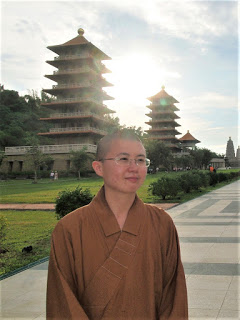
Speaker: Ven. You Lu
Fo Guang Shan Buddha Museum
I. Introduction
Hi everyone, thank you for tuning in to the English Dharma Services. This is You Lu, and today I would like to share the Ruru Jataka, which is the past life story of the Buddha when he was a deer. This story is from the Pali canon, Jataka No. 482, in the Jātakamālā compiled by Aryasura as Jataka No.26, and you can also find this jataka in the Chinese Sutra of the Collection of Six Paramitas.
III. Ruru Jataka
i. The Golden Deer
The Buddha once lived in a lush forest as a beautiful gold-colored deer adorned and resplendent with spots of nine different colors that shine like rubies, sapphires, emeralds, and beryls. With his large blue eyes of incomparable mildness and brightness, with his horns and hoofs endowed with a soft splendor, as if they were made of precious stones, this deer of surpassing beauty had the appearance of a moving treasury of jewels. Wary of hunters, the deer was careful to stay hidden from view and had never been seen by those who frequented the forest.
ii. The Deer Saved A Drowning Man
One day the deer was alerted to the cries of a drowning man who had fallen into a fast flowing river flooded by rain, and he thought, “Human lives are extremely rare and precious, should his life come to an end just like this? I should save him now from danger!”
With no regard for his own safety, the deer plunged into the water and dragged the drowning man to the riverbank. The man was very grateful and he pledged to be forever in the service of his rescuer. The deer was humble, but asked the man to protect him from hunters by continuing to keep his existence a secret. The man promised never to tell anyone about the deer.
iii. The Hunt for the Deer
One day the queen of the country dreamed of the deer in the forest. When she woke the next morning, she told the king, “My lord, I have dreamt of a beautiful gold-colored deer coated with spots of jewel. Now that I have dreamt of this deer, if I do not have the deer’s coat for my dress, and the antlers for my jewelry, I would die.”
A reward was posted, promising riches and land to whoever should find and capture the deer. The man who had been rescued by the deer, saw the notice and thought, “Since the deer had risked his life wanting to save me, why should I worry about keeping my promise? I might as well go for this reward.” He then went to the palace and offered to lead the king’s hunters to the deer. As soon as he disclosed the deer’s whereabouts, boils started to appear on his body.
iv. The Recounting of the Truth
The king then led a large troop of army, and with the guidance of the man, they came to where the deer was.
At this time, the deer was still sleeping and his good friend, the crow, tried to wake him up but in vain.
The crow then pecked his ears and cried, “The king is here to kill you!”
The deer woke up in shock and saw the king’s army pulling their bows, ready to shoot their arrows at him. Knowing that he was about to die, he braved up and approached the king. Explaining who he was, and asking who had led the hunters to him, he explained that he had been betrayed by a man whose life he had saved.
The king was angry and berated the man, but the deer explained that the temptation of riches was too much for some people to resist and that such desire weakens integrity. The king, upon hearing such wisdom agreed to pay the man his reward and also granted the deer freedom to walk the forest without fear. The king promised that from then on, all deer in his kingdom would be protected.
When the king returned to the palace, he told the queen what happened, and hearing that the king had returned without the deer’s coat and antlers, she was so furious that she died from anger and was reborn in hell.
v. The Web of Connection
Having recalled this jataka, the Buddha said to his disciples, “At that time, I was the deer, Ananda was the crow, Sariputra was the king, Devadatta was the man, and Devadatta’s wife was the king’s wife.”
VI. Ruru Jataka and Diligence
In the Sutra of the Collection of the Six Paramitas, this jataka was classified under diligence. The practice of diligence is to recognize the path to enlightenment, and to make a determination to stay on it at all times, whether one is walking, standing, sitting, or reclining. The Buddhist context of diligence also indicates the courage to help others, even if it means putting oneself in danger.
In this story, the deer puts himself at risk, firstly, of getting drowned in the gushing river, and secondly, of being caught sight of by human beings. What made him jump into the river was the sight of someone drowning, and wanting to save the man, he was willing to put himself in danger.
And what diligence also indicates is that we should cherish our human birth. In the story, what came to mind when the deer saw the man, was that a human birth is hard to encounter, and so that is why the deer is willing to save the man at any cost. When the man was rescued, the man was grateful to the deer for having saved him. However, seduced by wealth, he betrayed the deer, and eventually turned into a leper. This is such a waste of precious human birth! In fact, if we look at these jataka stories that we have covered in these three sessions, Devadatta was a human being in each jataka, and the Buddha was an animal. But even though Devadatta was a human being, he committed harmful acts toward the Buddha and was reborn in hell again and again. On the other hand, even though the Buddha was an animal, he practiced and perfected the paramitas, and eventually attained enlightenment.
What this story tells us about diligence, is that we should be clear about the goal of where we are heading, and to stay diligent towards this goal. Like what Venerable Master says in Buddha-Dharma: Pure and Simple,
Diligence inspires the cultivation of all wholesome deeds, and calls for all merit and virtue. Without the practice of diligence, the remaining five of the Six Perfections cannot be achieved. According to the Great Perfection of Wisdom Treatise, diligence is the foundation of all wholesome states; it give rise to all Dharmas, eventually leading to the attainment of anuttara samyak-sambodhi.
V. The Practice of Patience
When we talk about diligence, there are many different forms of diligence. We can be a diligent student when it comes to studies, or we can be a diligent staff member when it comes to work, or maybe we can even be a diligent fan when it comes to catching up with the latest drama series if one’s idol acted in it. But in the Buddhist context, diligence here means to stay on the path regardless of any circumstances, even at times when you are betrayed.
In many jatakas, the Buddha has repeatedly been hurt by Devadatta, but that doesn’t stop the Buddha from practicing compassion toward Devadatta, because he knew that by practicing continually, he will ultimately attain Buddhahood.
Thus diligence is about cultivating the habit of practice, until it becomes a part of your life. The most difficult part of the practice is when you encounter someone who turns his back on you even though you have helped him. If we hesitate or procrastinate to be kind and compassionate at times like this, then our practice becomes weaker; on the other hand, if we can persevere on the practice, then it becomes even stronger. Thus it is important to have a clear vision of why we are doing our practice, that we have a long-term goal of perfecting our Buddha nature. Then at the end of the day, what is truly important and meaningful to us, is not how well or how badly others have treated us, but how much we have progressed on the spiritual path lifetime after lifetime.
VI. Conclusion
Finally, let’s take a look at this mural of the Ruru Jataka from the Mogao Cave 257 in Dunhuang, China. The narrative begins from both ends and culminates at the center. The image of the deer is simple yet full of spirit, painted mostly in profile with multi-colored speckles. The people are likewise rendered simply, the men are bare-chested and adorned with long stoles that indicate movements. The mural is recognized as a classic in terms of both palette and design of characters. But the composition of this work is even more ingenious. While illustrating a story full of twists and turns, with the main characters appearing repetitiously in the same scene, the mural still looks concise and succinct.

That’s all I would like to share tonight. Thank you for being so diligent by listening to this talk. I will see you next season, bye bye!

